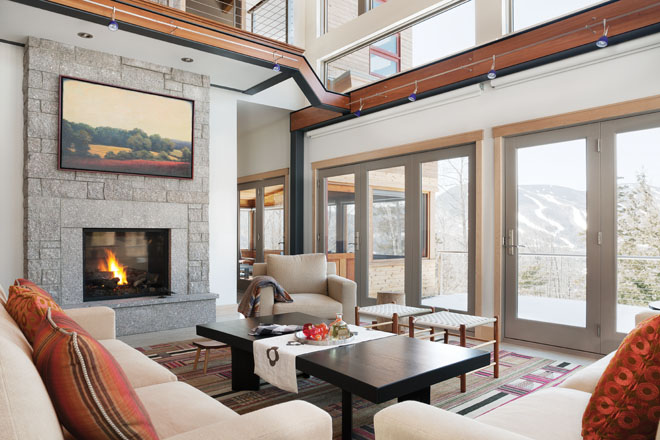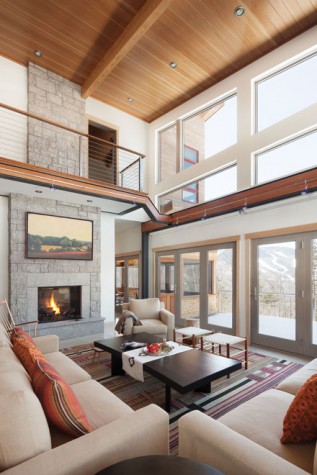Modern on the Mountain
FEATURE – January 2013
By Rebecca Falzano | Photography Trent Bell | Styling Janice Dunwoody
Shaker sensibilities expressed in twenty-first-century materials at Sunday River.
If there is an outdoor activity Leslie Jones and Ian Kirschemann haven’t tried, it’s because it hasn’t been invented yet. The couple will joke that they built their house in Newry because they needed a place to store all their gear—”just a few bedrooms attached to a large sports storage space,” they say with a grin. If this were true, it wouldn’t be all that surprising. The two are skiers, hikers, backpackers, kayakers, snowshoers, snowmobilers, fly fishers—the list goes on and is growing (they tried dog sledding last year). This is a couple who is in their element in the elements. Give them snow, wind, ice, and cold—they’ll do just about anything in any weather, as long as it’s outside.
But for Jones and Kirschemann, who have been coming to Sunday River for 20 years, the mountain is more than just a playground. “We were first attracted by the resort’s ability to manage snow conditions in the unpredictable East Coast weather, but immediately fell in love with the casual, outdoor lifestyle across all seasons,” says Jones. Within a couple of years, they had purchased a townhouse on the mountain. The couple’s jobs require a great deal of travel, so Sunday River became the emotional center of their family life. They made every Christmas a white one by celebrating in Maine. When their daughter got married, the wedding was at Sunday River; that’s where they’d always gotten together as a family. They took their guests hiking on the Appalachian Trail, cruised the mountains on ATVs, and went fly-fishing and golfing. The out-of-towners—mostly from the Midwest and the South—were stunned by the beauty of the Maine mountains, and Jones and Kirschemann were thrilled to share it with them.
While the couple’s townhouse offered convenient ski-in/ski-out access, they longed for a quieter, more private experience—a property where the only sound was that of the wind in the trees. Then one day they drove up the barely cut main road at Mount Will. There they found the peace and quiet they were seeking. “Actually, the site found us,” says Jones. “We selected it because it has lovely views but is also tucked away.”
Jones and Kirschemann describe their style as simple, spare, and linear. At their home in Pennsylvania, they collect museum-quality American Federal furniture. Here, near the Sabbathday Lake Shaker Community, they wanted to evoke a Shaker aesthetic with modern materials. Federal and Shaker styles both share the couple’s preferred design principles, though the former tends toward formal elegance while the latter makes room for elements of local culture. “Look around New England mountain villages,” says Jones. “They aren’t filled with houses that look like they would fit in at Aspen. Good architecture is one with its environment and local culture, not an imported style imposed upon it.”
To make sure their house would reflect the vernacular of the region, Jones and Kirschemann searched for a local team. When you live in Philadelphia and Chicago, travel extensively for business, and are building a house on a mountain in Maine, you need to trust the taste of the people you are hiring, and Bruce Lilly of Clearwater Builders in Bethel had a reputation as the pre-eminent builder of luxury homes in the area. The couple clicked with him immediately. “He listened so carefully to what we wanted and then made recommendations that were devoid of a personal agenda,” explains Jones. “We made a lot of the structural decisions based on asking him, ‘What would you do if this was your own house?’ He and his construction lead, Eric List, had an almost sixth sense of what would fit with our vision and what would not.”
That included the right architect. For the design, Lilly recommended Portland architect Matthew Winch, who had done both residential and commercial projects, including work for the Maine Huts and Trails system. Winch understood the mountain locale well and immediately grasped their vision. Most important, instead of being taken aback when they described their Shaker-meets-Ray-Kappe aesthetic, Winch was energized. “It’s probably not the traditional choice for a mountain home in Maine,” admits Jones, “but we especially appreciated the amount of time he spent understanding exactly how we wanted to live in the space.”
Winch approached his architectural design with one major question in mind: What kind of house would the Shakers build if they were to use modern materials? The aesthetic would have to be designed into the house from the beginning, an inherent piece of it, rather than applied after the fact like a trim. All the bedrooms are designed to be the same size, all the baths use the same fit-out, all the cabinets are identical. “I don’t subscribe to the idea of trying to design something to look old. I’d rather take those classic values and try to interpret them in a modern way,” explains Winch. With a design centered on simplicity and functionality from the start, the floor plan contains private spaces connected in an open layout; for example, when guests are watching a movie in the family room, they can carry on a conversation with someone in the kitchen or on the other side of the fireplace in the living room. “We wanted it to live like a small house when just Ian and I are there, but expand when we have family staying with us,” says Jones.
The resulting design features two-story volumes and massive amounts of glass—every inch open, modern, linear. Exposed steel beams with cherry inlays tell the structural story of the house and are a modern expression of the Shaker values of “form follows function” and simple details. “With so much exposed steel, beams, openness, and a lack of any shear walls to speak of because of all the glass,” says Winch, “there were definitely some head-scratching moments with the structural engineer.” Throughout the house, hard, square angles dominate; the intent was for a “very crisp feel.”
The homeowners dubbed the house Birch Barn in honor of the natural woodlands on the 15-acre property. To harmonize the surrounding environment, Winch designed for ample wood on the inside, with visible knots and imperfections revealing the material’s inherent beauty. “We wanted the materials to assert themselves for what they are,” says Jones, “for the house to be an expression of its location.” Since the natural surroundings are an important theme throughout the design, preserving the site and minimizing forest clearing were of paramount importance to Jones and Kirschemann. “We wanted to feel that we were in the living woods, not atop a clear-cut area.” Keeping as many trees as possible (not to mention planting an additional 50) made construction more challenging, but it paid off aesthetically as well as environmentally. The result is that the house disappears into the landscape, almost hidden from view.
As the house’s exterior blends into its setting, from inside all eyes are on the mountain. In the distance, it looms large and beautiful, a constant reminder of the snowy peak where families go to play.














